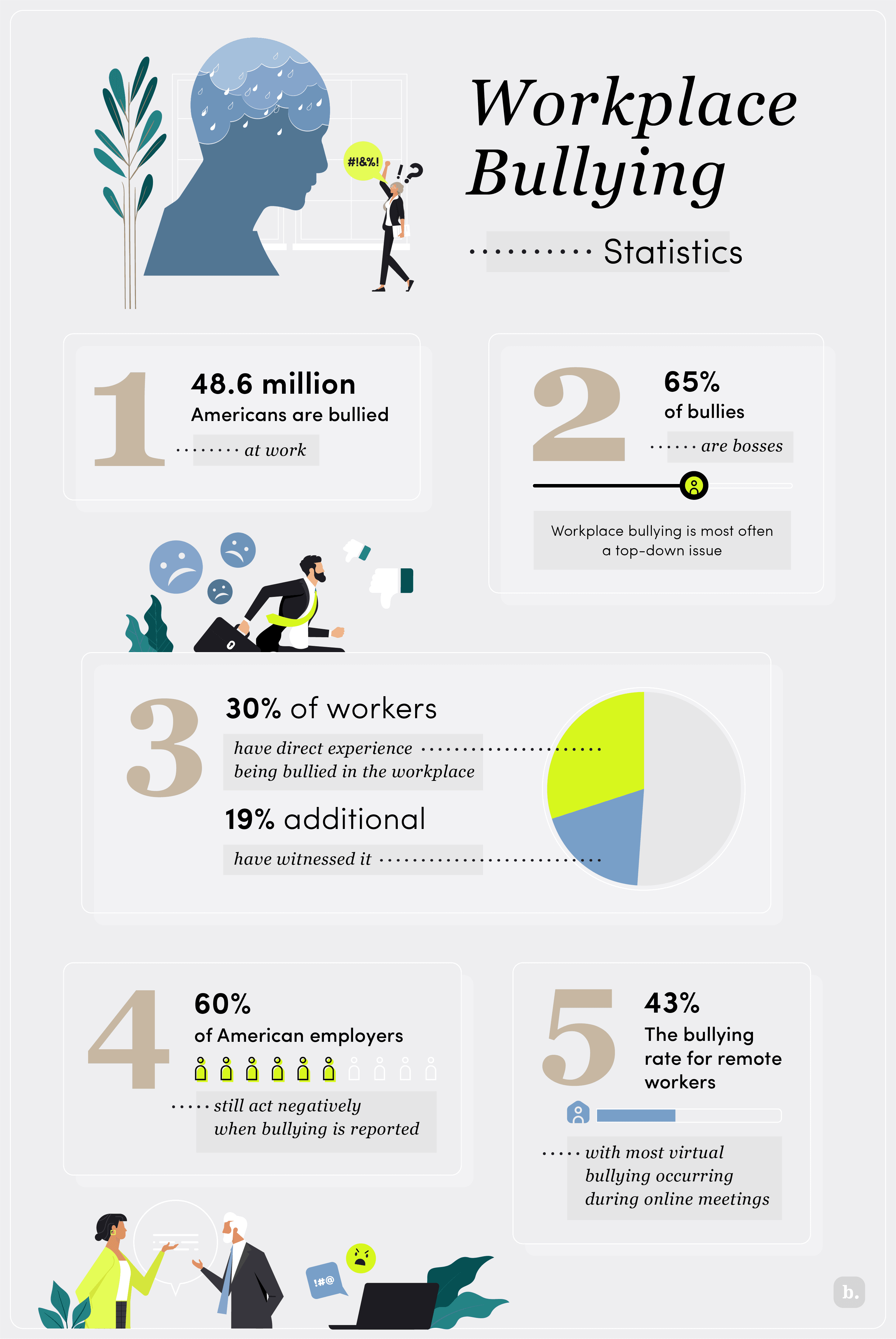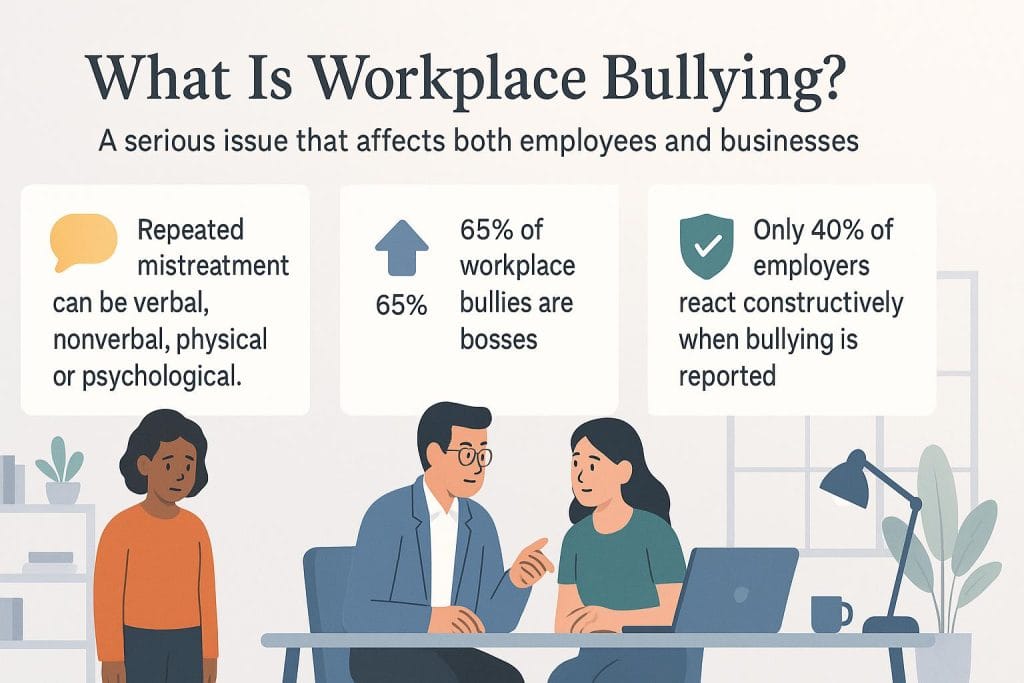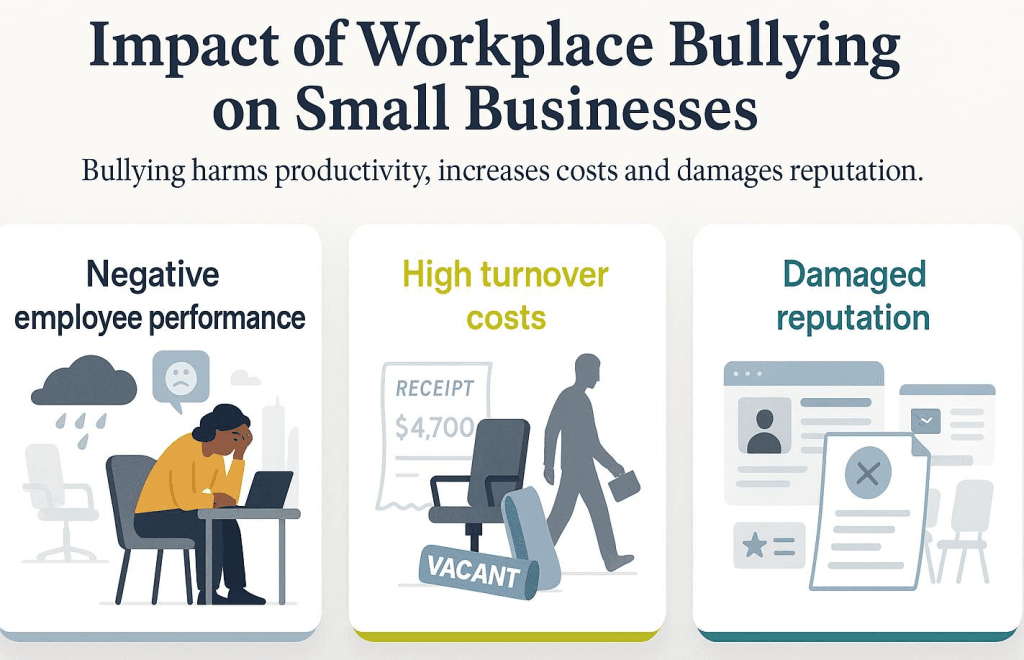Business.com aims to help business owners make informed decisions to support and grow their companies. We research and recommend products and services suitable for various business types, investing thousands of hours each year in this process.
As a business, we need to generate revenue to sustain our content. We have financial relationships with some companies we cover, earning commissions when readers purchase from our partners or share information about their needs. These relationships do not dictate our advice and recommendations. Our editorial team independently evaluates and recommends products and services based on their research and expertise. Learn more about our process and partners here.
Bullying in the Workplace: How to Identify and Handle It
Learn how to spot workplace bullying and stop it in its tracks.

Table of Contents
We can all agree that bullying is wrong, but that doesn’t mean it doesn’t happen in the workplace. According to a 2024 Workplace Bullying Institute survey, an estimated 52.2 million Americans are bullied at work.
The survey found 32.3 percent of workers have direct experience being bullied in the workplace and an additional 22.6 percent have witnessed it. Learning how to effectively identify and handle bullying at work is the first step toward a more inclusive and safer workplace. Below is our expert guide on identifying bullying in the workplace, as well as how workplace bullying impacts businesses.
What is bullying in the workplace?

Workplace bullying is the repeated mistreatment of someone in the workplace, whether it’s verbal, nonverbal, physical or psychological. Workplace bullying may be perpetrated by a single person or a group, and it may occur one-on-one or in front of others, such as clients, teammates or customers.
“Bullying consists of unwanted, harmful actions that humiliate, offend, harm, undermine or degrade, and can cause lasting physical and psychological damage,” said Kim Williams, spokesperson for End Workplace Abuse. “It hurts people and it hurts businesses.”
Although anyone can commit workplace bullying, it is most often a top-down issue, with 55 percent of bullies being bosses. There are many reasons why someone may bully another person at work, but the driving factor is often the bully’s personality.
Although roughly half of U.S. workers have some form of experience with workplace bullying, the consequences to the perpetrators remain minimal. For example, 62 percent of American employees who were bullied lost their jobs, compared to 27 percent of their perpetrators who faced negative consequences.
In most cases, bullying ends only when the target quits, gets fired, is constructively discharged or transfers. This leaves a lot of room for improvement when it comes to eradicating bullying in the workplace. [Related article: What Is Considered Wrongful Termination?]
“It’s not about one bad moment,” said Dr. Heather Lamb, a workplace wellness expert. “It’s a pattern. A slow grind. It’s when someone keeps getting undermined, excluded or singled out in a way that chips away at their confidence over time.”
Workplace bullying in a virtual world
Even though many employees have moved to a remote or hybrid work arrangement in recent years, bullying can still be a problem for your business. Workplace bullying may happen not only in a physical office but also in a virtual workspace.
In fact, the Workplace Bullying Institute found that 66 percent of those working hybrid roles were exposed to bullying (as a victim or a witness). Fully remote workers were bullied about 32 percent.
Workplace bullying outside of work
If bullying occurs between two or more of your employees, it can be considered workplace bullying, even if it takes place outside of work. For example, one scenario to look out for is on social media. If co-workers are connected on social platforms like Facebook or LinkedIn, a bully may choose to use one of those outlets to antagonize their victim.
Bullying can also happen outside the office at company social events, like happy hours, team-building exercises and company parties. In addition to bullying an employee during a company social event, excluding someone from an event can also be considered bullying behavior.
How do you identify bullying at work?

Workplace bullying can present itself in many forms, so it’s important to be on the lookout for a variety of unacceptable behavior that may occur throughout your workforce. Educate yourself and your team about which types of actions and behaviors are considered workplace bullying.
Here are some negative behaviors to look for when identifying workplace bullying:
- Intimidating, undermining, or hostile comments or gestures
- Persistent teasing or humiliation
- Passive-aggressive comments or insults
- Constant unfair criticism or blame
- Taking credit for another employee’s work
- Isolation or exclusion of another employee
- Making impossible demands or deadlines
- Aggressive verbal or nonverbal communication (including digital communication)
A bullied employee may show the following behaviors, according to Lamb:
- Fear of or unwillingness to speak up
- Frequently calling out sick
- Sudden withdrawal from groups
- General discomfort/unease
“If someone leaves a meeting feeling small every single time, that’s not normal — it’s a red flag,” Lamb explained. “If they’re questioning their worth or constantly second-guessing themselves because of how someone talks to them, we need to look closer.”
Since these actions can occur in a physical or virtual work environment, it’s important to keep open communication with your team to ensure no one becomes the target of such behavior. Workplace bullying may not always be apparent, so encourage employees to speak up about mistreatment as soon as they identify it.
How do you handle workplace bullying?
Workplace aggression is a serious problem that can affect an employee’s mental health, destroy their livelihoods and significantly change lives. Part of the issue is that many employers don’t handle bullying instances properly.
The Workplace Bullying Institute reported that employers tend to encourage, defend, rationalize, discount and deny bullying. As an employer or manager, you have a responsibility to stop workplace bullying in its tracks. One of the best ways to do this is to implement a zero-tolerance policy when it comes to bullying.
Here are several steps you can use to handle and reduce bullying in your workplace:
- Educate employees on what classifies as acceptable and unacceptable workplace behavior.
- Require employees to take anti-bullying and anti-harassment training.
- Identify and control potential risks.
- Conduct exit interviews, ask questions and communicate with your team to gain insider knowledge about possible issues.
- Recognize changes in employee relationships (positive and negative). [Read related: How to Improve Relations Between Your Managers and Employees]
- Engage with underperforming employees to root out potential abuse.
- Implement reporting and response procedures, including an open-door communications policy.
- Encourage honest and open reporting.
- Act promptly when reports surface or if aggression is identified.
- Treat all matters seriously.
- Maintain confidentiality and sensitivity.
- Be neutral to ensure fairness.
- Keep detailed records of each indiscretion (e.g., the people involved, what was said or done, where and when the abuse occurred).
- Evaluate your workplace policies at least once a year to ensure they are up to date with any workplace changes. For example, you may need to extend your policies to cover specific virtual behaviors if your employees have moved from an in-office setting to a remote work environment.
Although some instances of bullying may not be federally regulated, most informed Americans support legislation providing protection from workforce aggression. Currently, 32 states have introduced a version of the Healthy Workplace Bill, which aims to precisely define an “abusive work environment,” providing specific rights for victims and protecting employers that take action against workplace bullies.
Whether or not bullying is legally regulated in your state, it’s important to take it seriously and handle every matter with care. “People don’t expect perfection,” Lamb said. “But they do expect to be treated with basic human dignity. When we get that right, everything else — productivity, collaboration, innovation — has a foundation to thrive.”
How does bullying in the workplace impact small businesses?

As a business owner or manager, you should be concerned about workplace bullying for both financial and nonfinancial reasons. “Ignoring it can now be tabulated through measurable disengagement, mounting sick leave and high turnover,” Williams said. “But more than simply draining talent, toxic cultures are being etched into balance sheets through hefty legal settlements and reputational harm.”
Here are the biggest ways bullying can negatively impact small businesses:
- Negative employee performance: Bullying can have a major impact on employee mental health, which can eventually lead to anxiety, depression, burnout, disengagement and poor performance. This negatively impacts the employee as well as your entire organization.
- Financial losses: The costs of turnover, retraining, absenteeism, lost productivity and potential litigation are another reason business owners should be concerned about workplace bullying. On average, it costs $4,700 to hire and train a new full-time employee. So if one of your employees quits due to workplace bullying, your bottom line will take a big hit. “Based on generally accepted engagement and performance data, we can estimate that every peer of a toxic employee loses about 30 percent of their productive time,” according to Williams. “For direct reports, that number is closer to 50 percent. This means that you are losing 30 to 50 percent of your return on investment when it comes to salaries and benefits. And these costs can add up quickly.”
- Damaged reputation: It’s going to be hard to attract top talent to your organization if you get a reputation for tolerating bullies. If this behavior continually goes unaddressed and becomes baked into your company culture, it can have a lasting impact on your business and your ability to recruit new staff. Employees and job seekers place high importance on diversity and inclusion as well as company culture, and they won’t want to work for you if you tolerate bullying in the workplace.
- Loss of talent: Bullying can drive away your most successful, hard-working employees. “You don’t just lose people — you lose the best people,” Lamb warned. “You lose the ones who care, who take initiative, who lift others up — because those are the people who feel bullying the most.”
Sammi Caramela and Jamie Johnson contributed to the reporting and writing in this article.











